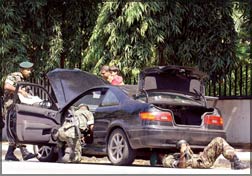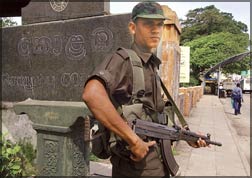|
dailynews |
|
|
|
|
|
OTHER LINKS |

|

|

|
2006 - a watershed year marking new horizons in national security
The painting that has been drawn on a parapet wall partly damaged from the pellets of the bomb that exploded on December 1 targeting Defence Secretary Gotabhaya Rajapaksa at Piththala junction says everything in a nutshell. The biggest challenge the country facing today is terrorism. It was not a new challenge for the country, but has been in existence like a cancer for the past few decades crippling the growth of the country. It is still a question whether Governments which were in power for the past two and half decades made any successful effort to free the country from terror.
It is unfair to say that no one had made any attempt to get rid of this problem. They all made attempts to salvage the country from terror. There had been many approaches to the problem. Though they differed from one Government to the other one unique feature in their efforts was that more emphasis was given to solving the problem by having a comprehensive approach, taking in the bigger picture. It was like treating the roots of a tree, expecting it to grow faster, ignoring the cancer on it. So, anybody who looks at the problem can simply understand it is useless to treat the roots of a tree with much care if the cancer is spreading all over the tree and crippling its growth. It is very unlikely for us to get better results from our treatment to the tree unless we remove the cancer and treat it. Even when we treat it while the cancer exists the tree will bear fruits but will not exist for long as the cancer can easily have an adverse effect on the tree and cripple it instantly.
So is the terrorism that has engulfed the entire country for the past few decades. It has become a bigger challenge for the country, to the extent that it has become the theme of the Ministry of Defence for 2007 and it is also the theme of the entire nation. But it was only one step ahead as the country has already laid a solid foundation during the year 2006 to free the country from terrorism. On the surface, many were at a loss to understand whether the Government was taking the path of war or the path of peace. It seemed to be a mixture of both. It was a situation created due to the disturbing of the smooth terror operation that was running under the cover of the Ceasefire Agreement. Many came to the conclusion that they were in a totally insecure environment in Colombo as they saw roadblocks and barriers back in the city in 2006. They were shocked when a suicide bomber blew herself targeting Army Commander Lt. General Sarath Fonseka within the Army Headquarters premises on April 25 and when the third in Command of the Sri Lanka Army Major General Parami Kulatunga was assassinated by another Tiger suicide cadre at Pannipitiya. But people were not aware that the LTTE opted for those desperate acts as their smooth operations were blocked by the Security Forces and the Police keeping them in the dark. The targets they had taken during 2006 clearly indicates how they were affected due to the actions taken by the Security Forces and the Police. Their first attempt was to take the life of Army Commander Sarath Fonseka as they saw him as a major obstacle for their secret terror operations in the North-East as well as in the South. The LTTE never expected Fonseka, who challenged the LTTE idea of dismantling High Security Zones in the North when he was the Security Forces Commander in Jaffna, to become the Army Commander and obstruct their covert terror operations in the entire country. But they miserably failed in their endeavour as the Army Commander survived the injuries caused by the pellets of the suicide bomb. They were successful in their attempt on Major General Parami Kulatunga who was well aware of the LTTE cadres operating in Colombo than any other in the Army. The LTTE feared that he would become the Army Commander. The attempt on the life of Defence Secretary Gotabhaya Rajapaksa was the climax of the events that unfolded in 2006 in the sphere of national security. The Tiger outfit made this unsuccessful attempt as they were well aware that he was the man behind all humiliating defeats they were facing both in the battlefronts in the North East and also the blockade of their terror operations outside the North East. But, can anybody come to a conclusion that Colombo's security was in jeopardy during 2006? There may be arguments and counter arguments to say that Colombo became insecure during the last year compared to previous years but can any of these incidents be compared with the assassination of Foreign Minister Lakshman Kadirgamar at his private residence in Colombo? Not only was he assassinated but also the perpetrator escaped from the High Security Zone after accomplishing his mission. Although the number of casualties during the 2006 was very high compared to the previous years the overall impact the LTTE made in Colombo was at a very low level. Going through the past records of the suicide cadres involved in Defence Secretary Gotabhaya Rajapaksa and Army Commander Lt. General Sarath Fonseka it was clearly evident that LTTE had used the Ceasefire Agreement and the absence of Anti Terrorism laws to establish their networks outside the North-East in support of their terror acts. Investigations have revealed that the suicide cadre who tried to take the life Defence Secretary Gotabhaya Rajapaksa was in Colombo since 2001. But he came into light only after incident. Until that fateful day, he lived in Colombo posing as a Muslim though he was not a Muslim. The woman involved in the Army Commander's suicide attempt also followed the same tactics. The Security Forces believe that LTTE must have deployed hundreds of such sleeper cadres using forged identity cards until they get instructions from Pottu Amman to accomplish their tasks targeting VVIPs and sensitive economic centres. The prime aim of the reintroduction of new regulations under the Public Security Ordinance was to arrest those suspected sleeper cadres without waiting for them to accomplish their targets, as it was impossible for the Police to arrest them and keep them under custody. It was very clear that there was a false sense of security in Colombo and other suburban areas though it appeared peaceful on the surface with roads sans barriers and with the Security Forces confined to barracks. It had provided ample opportunities for the LTTE for gun running and to maintain contacts with the underworld. The Service Commanders in a presentation made to President Mahinda Rajapaksa last year explained how insecure Colombo was under these circumstances and highlighted the need to have speedy action to take the situation under control. Added to that point was the remarks made by Anton Balasingham at Geneva I. They openly declared they had developed links with the underworld in the South to do their 'contracts' without using their suicide cadres. They used underworld gang leaders like Ice Manju for their contract killings in the South and developed their capabilities to control their operations from Wanni using these contract killers. The Police investigation teams were able to expose the LTTE links with the underworld after they seized five T-56 weapons from Gampaha area a few months back when investigating into the killing of Colonel Meedin. Investigations revealed that the LTTE was supplying weapons for the underworld gangs in exchange for the vehicles they hijacked from various places in the South for the Tigers in Wanni. The road blocks re-introduced last year enabled the Security Forces and the Police to detect a number of vehicles that had been hijacked by these underworld gangs when they were being transported to Wanni. The free access the Tiger cadres had in the South also paved the way for them to infiltrate the Security Forces and hire people to obtain inside information for their operations. The sense of insecurity was not confined to Colombo. The LTTE was operating in full swing in the cleared areas of the North East freely recruiting children to their battalions and providing weapons training for the civilians. The Tiger outfit used the freedom under the CFA to engage in political activities in the Government held areas to kill intelligence operatives and used the Political offices as their armouries. The steps taken by the Defence Authorities giving clear and specific directions to the Security Forces and the Police to conduct search and clear operations in those areas helped improve the security situation and confined the LTTE acts only to the uncleared areas. The operations conducted by the Security Forces without being offensive could bring the LTTE operations almost to a complete halt giving a sigh of relief for the people in Jaffna and other parts of the country specially for the Tamil community in the North and East. Today the people living in Jaffna are happy as their children are now having the opportunity to have a proper education at their schools free of fear about LTTE abductions. Steps were also taken towards strengthening the security of the threatened villages after reorganising and strengthening the Home Guard Service as a separate Department for the sole purpose providing security for threatened villages. Therefore, it is not fair to give judgements based on the number of casualties and the number of terror acts that occurred during last year since it was a transitional period to change the country from a totally insecure situation to a secure environment. Has the LTTE used civilians as a shield this time too?CIVILIAN CASUALTIES: The Tiger outfit has once again raised the issue of civilians becoming victims of air attacks by the Sri Lanka Air Force. They claim that 15 people including seven children had been killed due to the aerial bombing carried out by the SLAF on Tuesday morning in Illuppaikadavai, North of Mannar. It is unfortunate to see civilians being killed in any attack whether it was an act by the LTTE or the Security Forces. It should be subject to outright condemnation by all segments of society irrespective of any differences. However, the SLAF confirms they took the precise target after monitoring the activities of the Sea Tiger base which has been frequently used by the Sea Tigers for their arms smuggling. But things are not yet clear how civilians got caught in the air attack targeting the Sea Tiger base in Iluppaikadawai. According to Mannar Bishop Rev. Rayappu Joseph the site which came under aerial bombing was only 100 metres away from the shore and it was home to 35 families displaced from Navanthurai, Jaffna. The Bishop who visited the scene four hours after the scene with an escort from the LTTE also claims that he had not seen any sign of a military installation there. It should be highlighted that he had given ample time for the LTTE cadres to remove any such sign from the scene. The LTTE came out with the same type of media blitz when Chencholai Weapons Training camp came under the SLAF attack in the middle of last year. First they claimed that the school was bombed by the SLAF and later they claim it was an orphanage. But all their efforts turned futile when two victims of the Chencholai weapons training school exposed the truth to the entire world when they were admitted to a hospital in Kandy few weeks after the incident. It was unfortunate that one of the girls who exposed the LTTE barbaric act in Chencholai died under mysterious circumstances after she was suddenly transferred to Vavuniya hospital from Kandy. But the civilians who claim to be injured due to aerial bombing have not come out with their version yet. They are still undergoing treatment at Kilinochchi hospital which is located 80 kilometres away from the site of the bombing according to the same Tamilnet story. It is obvious that LTTE had purposefully taken civilian casualties to Kilinochchi hospital to cover up the real picture of the story. As exposed by this column a few months back the LTTE was using these displaced civilians as human shield to cover up their military installations. Therefore, it seems that this is yet another case to depict the use of displaced civilians as a human shield to cover up their Sea Tiger bases as they do in Vakarai to veil their gun positions to put the blame on the Security Forces once civilians got caught in the crossfire. Therefore, it is up to independent authorities who have access to the place to come out with the truth behind the LTTE claim and urge the LTTE to prevent from such acts. |











